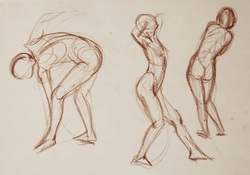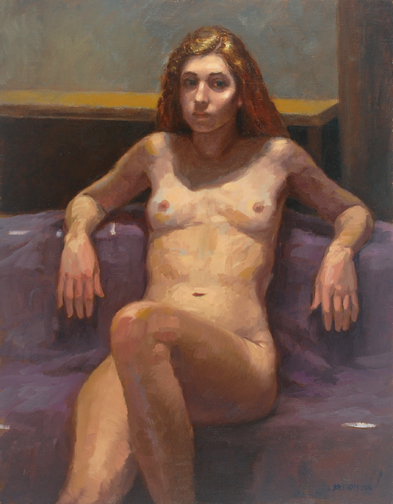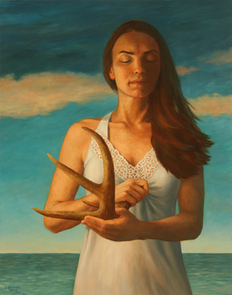|
Many artists consider representing the human form to be the ultimate challenge, and I am one of them. Artists who specialize in portrait and figure painting strive for years to master it, and have to keep practicing just as an athlete has to exercise. Even artists who normally exhibit only landscape, still life or abstract art will return to sketching the figure from time to time. It’s hard to find friends who are willing to sit still and be stared at for hours, and hiring a professional artist’s model is expensive. We are lucky in Seattle to have several group studios at which to practice drawing and painting from a nude, portrait or costumed model on a regular basis. I like to go to the Open Studio sessions at Gage Academy of Art when I can. They commonly schedule short pose or long pose (3 hour) sessions almost every day, and are open to artists on a drop-in basis for a reasonable fee.  At short pose sessions, poses range from less than a minute to 20 minutes. Quick drawings are called “gesture drawings” and the goal is to capture the flow of the pose, the feeling of the weight and pull of the model’s muscles, in a few lines. The artist should almost become the model. These are valuable to train the eye and hand to respond intuitively to the subject. In the longer poses one can spend more time measuring proportions and angles, and then adding details and shading, but I believe the initial gesture sketch is still the most important element in capturing the gestalt of the person before you. Sometimes an art school or group of artists will hire a model to repeat a pose for an extended number of sessions so they can complete a more resolved study. I have attended a few of these, and use the sessions to try out various approaches to painting form—systematic classical processes like drawing first, proceeding with monochrome paint, then layering of color, etc.; or direct processes such as alla prima, with brush drawing and using full color from the start. Often I find myself diverging from my initial plan as the painting evolves, from lack of patience or changing goals. Painting with a group of other artists and responding to the figure in front of you is different from working alone in one’s studio. There is the camaraderie of the other artists, with whom you can share painting tips, and there is the personality of the model. Some are more talkative and open about their lives, and others are strictly business. I think of him or her as an actor on stage, and for a successful painting, I must imply a mood or a bit of a story to make the scene interesting. A painting or drawing of a figure model “just” standing or sitting there can be a fine thing if skillfully rendered, but it needs something special to transcend being an exercise in anatomy and to draw in the viewer if it is going to be exhibited. Some artists are able to do it with beautiful marks with the pencil or paint, or an interesting perspective; others can find something special in the expressiveness of the face or pose.  Earlier this year I attended a series of morning “reserved easel” sessions at Georgetown Atelier to paint a lovely young model. My strategy for this study was to do a drawing at the first session, getting the feel of the pose and deciding the composition of the painting. Next I loosely sketched the composition on a small linen-covered panel in charcoal and began to paint. I decided to keep the study monochrome until the shapes and values were fully resolved, and for this I used burnt umber and lead white. I spent two or three sessions on this; the lighting was challenging since my back was to a bank of large windows and the light and shadows changed dramatically as the sun rose and storms moved through, conflicting with the strong lamp above the model. I practiced using thicker paint and looser brush strokes, fighting my tendency to over-blend. During the final couple of sessions, I started adding color, but kept it muted, as there was not a lot of color in the scene. I started this study with no expectations other than a learning experience, and I am pleased with parts of the resulting painting. Right: Young Woman in a Shadowy Room, 16” x 12”  A few times I have hired a model to come to my studio and pose for more complex paintings. I used the model as an actor in a scene that had implied narrative, which was not fully pre-conceived but evolved as I worked with the model and then added background and other elements without her presence. In the end, the final product may not even look like the model as it takes on a life of its own. Two of these paintings that I made a few years ago will be hanging in an exhibit called “Figuratively Speaking” at Ida Culver House Broadview (12505 Greenwood Ave. N., Seattle), curated by June Sekiguchi. There will be a reception with wine, hors d’oeuvres and music on May 19 from 3:30 to 5:30 that is open to the public; please RSVP to 206-361-1989 by May 16 if you would like to attend. The exhibit will be up, in the lobby and public areas of the building, until September 11, 2016. Left: Sleepwalker, 2006, oil on canvas, 28" x 22"
1 Comment
Kathleen
5/11/2016 12:09:23 pm
Lovely!
Reply
Your comment will be posted after it is approved.
Leave a Reply. |
AuthorHere I will keep you up to date on my exhibits and other artistic endeavors. Archives
March 2024
Categories |
 RSS Feed
RSS Feed